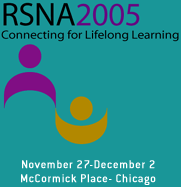
Abstract Archives of the RSNA, 2005
Ho Kyu Lee MD, Presenter: Nothing to Disclose
Wendy R.K. Smoker MD, Abstract Co-Author: Nothing to Disclose
Amr Mourad, Abstract Co-Author: Nothing to Disclose
Toshio Moritani MD, PhD, Abstract Co-Author: Nothing to Disclose
Joan Elizabeth Maley MD, Abstract Co-Author: Nothing to Disclose
Yutaka Sato MD, Abstract Co-Author: Nothing to Disclose
1.Understand the anatomy of the pre-epiglottic and paraglottic spaces.
2.Recognize the variety of pathologies that affect the pre-epiglottic and paraglottic spaces.
The pre-epiglottic space (PES) is a midline, horseshoe-shaped, fat-containing space and the paraglottic spaces (PGS) are paired, peri-epiglottic spaces. Glottic carcinomas typically spread to involve the PES and PGS. Occasionally, other pathologies can superficially or deeply involve these spaces. Pathologies are broadly categorized as follows: i) mucosal lesions-laryngeal or pyriform sinus carcinoma; ii) submucosal lesions-schwannoma, hemangioma, minor salivary gland neoplasm; iii) cartilaginous or adjacent tissue lesions-chondroma, chondrosarcoma, rheumatoid arthritis, thyroglossal duct cyst; iv) laryngeal saccular lesions-laryngocele; v) diffuse lesions- laryngopharyngitis, laryngeal edema, tuberculosis, lymphoma, etc.
The purpose of this exhibit is to review the anatomy of the PES and PGS on CT and MR imaging. In addition, a wide spectrum of pathology affecting these spaces is illustrated and discussed.
Lee, H,
Smoker, W,
Mourad, A,
Moritani, T,
Maley, J,
Sato, Y,
Pre-epiglottic and Paraglottic Spaces: Anatomical Considerations and Disease Spectrum. Radiological Society of North America 2005 Scientific Assembly and Annual Meeting, November 27 - December 2, 2005 ,Chicago IL.
http://archive.rsna.org/2005/4414961.html

